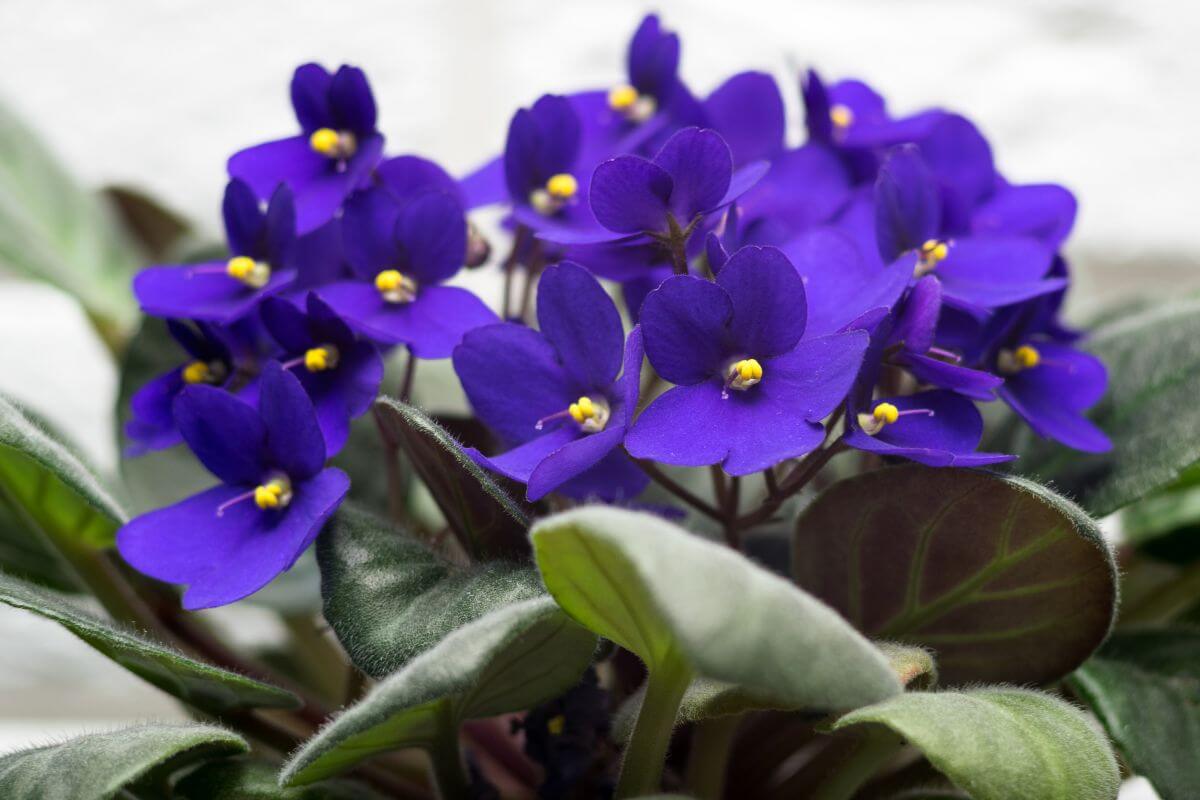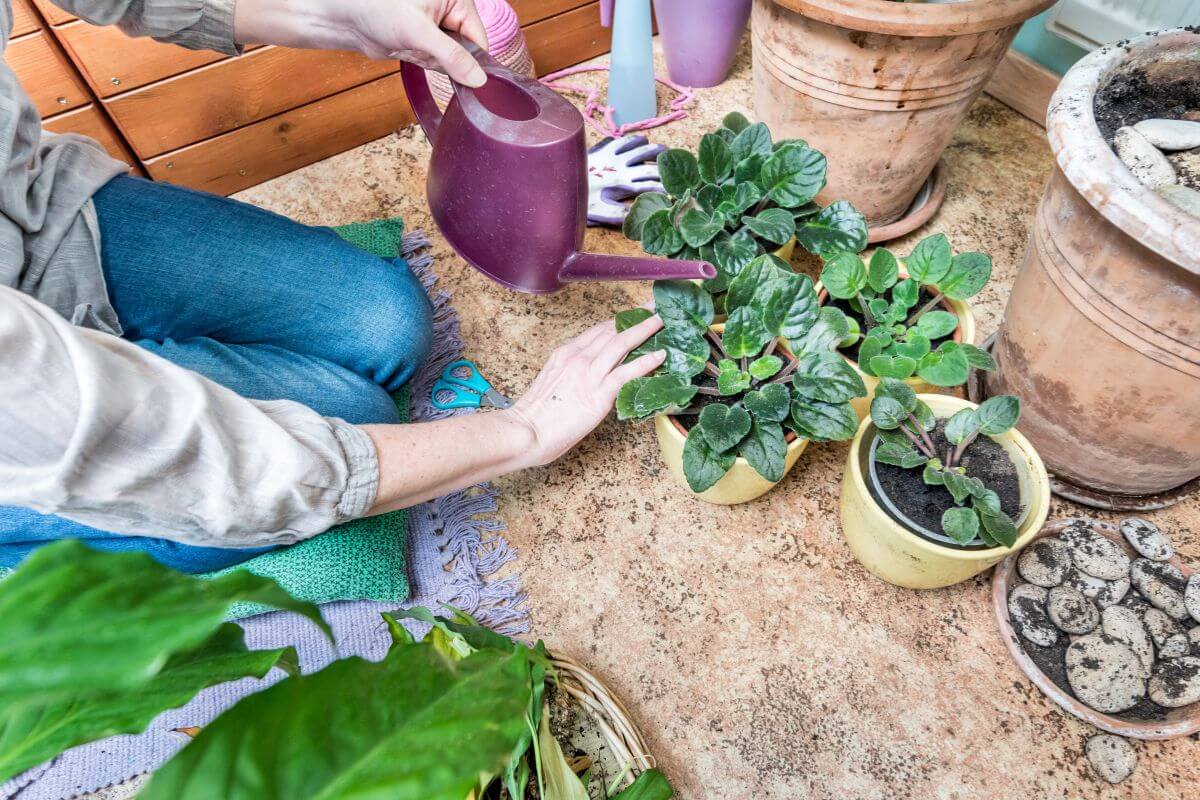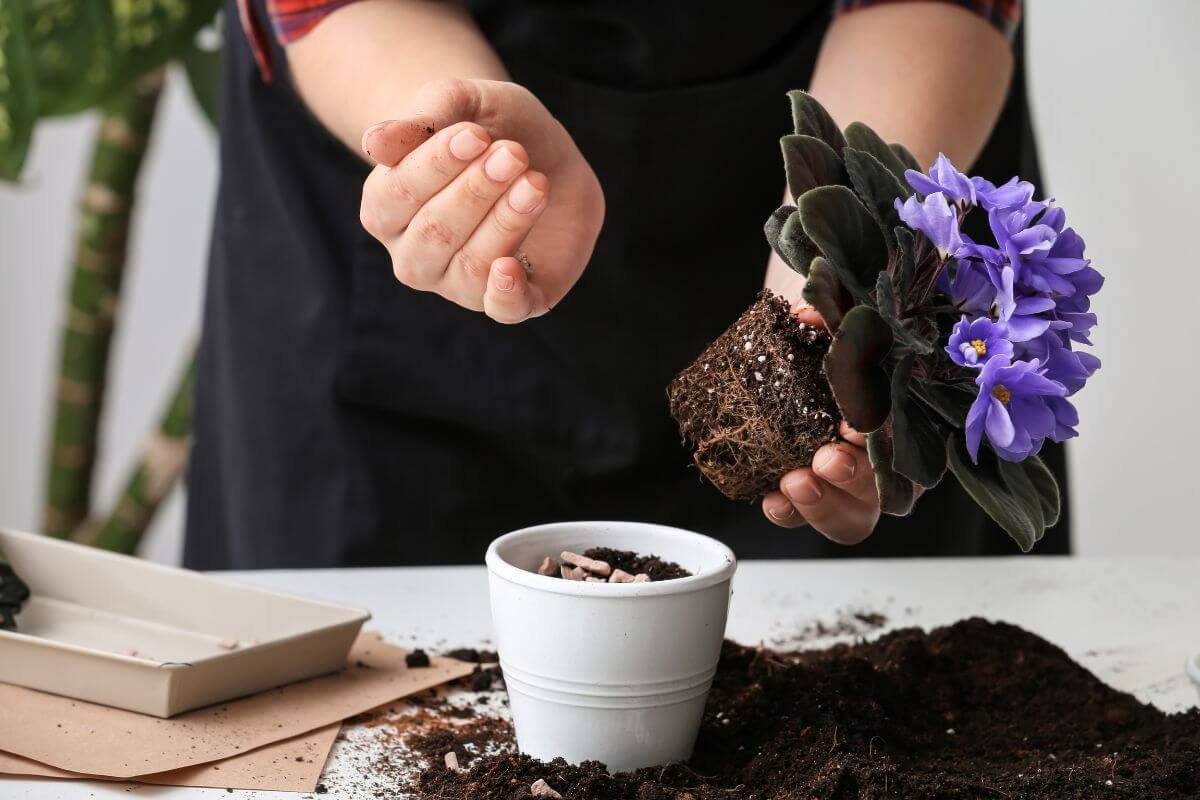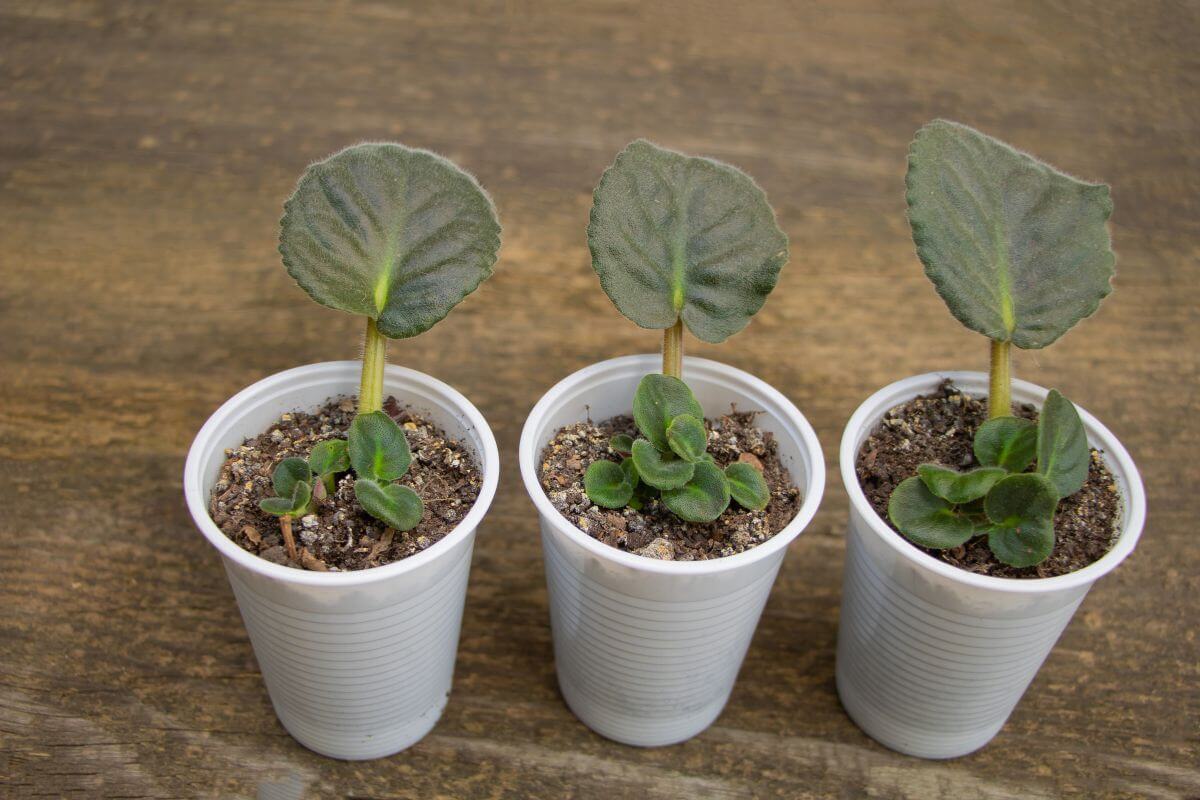African Violets are incredibly popular houseplants. They are low-growing and come in many colors with various leaf forms. These compact plants bloom several times a year.
Many people think African Violets are hard to grow indoors. But with a few simple tips, your plant can thrive.
These plants can grow as large as dinner plates. They can bloom all year round, adding beauty and color to your home.
I’ll share some care tips and useful information about growing African Violets.
7 Key Takeaways on African Violets
- African Violets are loved for their bright, velvety flowers. You can find them in purple, pink, white, and even mixed colors.
- They need warm, humid places with bright but indirect light. Aim for around 1000-foot candles of light.
- Use a special African Violet potting mix that drains well to avoid root rot. Repot them every 1-2 years into a slightly bigger pot.
- Water from below to prevent leaf spots. Keep the soil moist but not soaked. Usually, watering once a week works.
- Feed them with a balanced, water-soluble fertilizer every 2-4 weeks when they are growing. Avoid fertilizers with high urea nitrogen.
- You can easily grow new plants from leaf cuttings, offsets, or seeds. Leaf cuttings usually root in about 6-8 weeks.
- Keep an eye out for pests like Cyclamen Mites, Mealybugs, and Thrips. Also, watch for diseases like Crown and Root Rot or Powdery Mildew. Good airflow and cleanliness help prevent these issues.
An Overview of the African Violet

African Violets, also known as Saintpaulia ionantha, are colorful indoor plants that you can grow in your home. They have vibrant, velvety flowers that come in purple, pink, white, and bicolor. These plants belong to the Gesneriaceae family and come from the tropical forests of eastern Africa.
| Feature | Description |
|---|---|
| Scientific Name | Saintpaulia ionantha |
| Common Names | African Violets |
| Family | Gesneriaceae |
| Origin | Tropical forests of East Africa, first found in Tanzania in 1892 |
| Size | 6-12 inches tall and wide |
| Growth Pattern | Rosette growth pattern with fuzzy, rounded leaves |
| Flowers | Vibrant, velvety flowers in purple, pink, white, and bicolor; 1-2 inches wide in clusters above leaves |
| Leaves | Oval to heart-shaped, velvety, ranging from light to dark green, some with variegation |
| Roots | Shallow, fibrous roots; prefer to be slightly pot-bound |
| Propagation | Easy to grow from leaf cuttings |
| Blooming | Can bloom for many months with proper care |
| Toxicity | Non-toxic to dogs, cats, or humans according to the ASPCA; fuzzy leaves do not irritate skin |
African Violets are easy to care for and can bloom for many months with proper care, making them one of the world’s most loved houseplants. The ASPCA states that they are not toxic to dogs, cats, or humans, though keeping them away from small children is wise.
How to Care for Your African Violet
The African Violet thrives in a warm, humid, and bright spot.
Remove dead leaves or flowers to keep your plant happy and healthy. Dead leaves on the soil can lead to rotting.
Keep the soil moist and allow fresh air. Sunlight is important but avoid damaging the leaf tips.
If you hit rough spots, don’t worry. With some experience, you’ll have beautiful African violets at home.
Soil Requirements for African Violets
African Violets thrive in a well-draining, porous potting mix. This mix should hold moisture but also allow air to reach the roots. Specialized mixes like Black Gold African Violet Potting Mix work well because they contain peat moss, perlite, and vermiculite.
Choosing the right soil is important. African Violets can get root rot if the soil stays too wet. Let the soil dry out a bit between waterings.
These plants like being a bit cramped in their pots. Repot them every 1-2 years into a container just a bit bigger than the last one. This helps them flower better.
Don’t use regular garden soil or heavy potting mixes. These can compact around the roots and cause issues. Aim for a slightly acidic soil pH, between 6.0 and 6.5. If needed, add a bit of dolomitic limestone to adjust the pH.
Temperature Requirements for African Violets
African Violets flourish in a temperature range of 65°F to 80°F, with the ideal being around 70°F. At night, a slightly cooler temperature of 65-70°F is preferred. Temperatures outside this 65-80°F range can cause problems for African Violets.
Temperatures below 60°F can make African Violets vulnerable to issues like crown rot, especially with excess moisture. Temperatures above 80°F can cause plant growth to become rangy, leaves to appear dry and faded, and flowers to drop off.
To maintain the ideal temperature, here are things you should know:
- Avoid drafts, air conditioning, and heating vents that can cause temperature fluctuations.
- Use curtains, blinds, or insulation to help stabilize the temperature around the plants.
- Adjust thermostat settings to maintain 70-80°F during the day and 65-70°F at night.
- Consider using grow lights in winter if home heating can’t maintain the ideal temperature.
- Circulate air with a fan, but avoid directing it directly onto the plants.
Light Requirements for African Violets
African Violets need bright, indirect light. Aim for around 1000-foot candles. This is usually found about 3 feet from a south or west-facing window. Direct sunlight can be too strong and make the leaves pale or yellow.
These plants need 8-12 hours of light each day. They can handle up to 16 hours of light but also need 8 hours of complete darkness for the best blooms. They may grow but not flower well if they don’t get enough light.
When natural light is scarce, use fluorescent or LED grow lights. Fluorescent lights should give about 600-foot candles for 16 hours daily. Commercial grow light systems with HID, compact fluorescent, or LED bulbs also work well.
Watch for signs of improper lighting in African Violets:
- Thin leaves reaching upward mean the plant needs more light.
- Pale or yellowish leaves mean the light is too intense.
- Poor flowering or no blooms mean the plant isn’t getting enough light.
Water and Humidity Requirements for African Violets

Water should never touch the leaves of your African Violets. It will cause brown spots. Avoid overwatering too because it can lead to root and crown rot.
Keep the soil moist with warm or room-temperature water. Cold water is not good.
Watering once a week might work. Check if the soil is dry first. Different potting soils need different watering schedules.
This plant loves high humidity. Mist it lightly sometimes to help.
Always water your African Violet from below. Or put the watering can spout directly into the soil. Water only when the soil feels dry.
Fertilizer Requirements for African Violets
To keep African Violets healthy, use a balanced water-soluble fertilizer made for them. Look for an NPK ratio of 20-20-20 or 15-20-15. It should also have micronutrients like iron, magnesium, and calcium. Avoid fertilizers high in urea nitrogen because they can harm the roots.
Fertilize African Violets every 2-4 weeks during spring and summer. In fall and winter, when growth slows, fertilize every 4-6 weeks.
Always water the plant first to prevent root burn. Use the recommended dilution rate, usually 1/4 to 1/2 teaspoon per gallon of water. Don’t get the fertilizer on the leaves to avoid spots.
Drench the soil until water runs out the bottom of the pot. This flushes out any excess salts.
How to Prune and Repot African Violets

Here’s a straightforward guide on pruning and repotting African Violets:
Pruning African Violets:
- Remove Dead Leaves – Gently pull off any dead or damaged leaves at the base of the plant.
- Trim Spent Flower Stems – Cut off flower stems after blooms fade to encourage more flowers.
- Pinch-Off Suckers/Offsets – Remove any suckers or offsets to keep the plant focused on the main crown.
- Avoid Cutting the Central Crown – Don’t cut into the central crown because it can harm the plant.
- Prune Sparingly – Only prune when necessary to maintain the plant’s shape and health.
Repotting African Violets:
Repot every 6-12 months or when the plant becomes rootbound. Spring or early summer is best. Choose a pot 1-2 inches wider than the current one to prevent overpotting. Use a well-draining, porous African Violet potting mix.
Steps for repotting African Violets:
1. Gently remove the plant from the old pot, keeping the root ball intact.
2. Place the plant in the new pot and fill around the sides with fresh potting mix.
3. Water thoroughly after repotting, avoiding disturbing the roots.
How to Propagate the African Violet

Propagating African Violets is easy and rewarding. Leaf cuttings are the most popular method. Here’s how you can do it:
- First, select a healthy leaf. Pick one from the middle of the plant. Avoid the youngest and oldest leaves.
- Next, prepare the cutting. Cut the leaf stem to 1-1.5 inches. You can dip the cut end in rooting hormone to help roots grow.
- Then, plant the leaf cutting. Use a well-draining potting mix for African Violets. Keep the soil moist but not soaked.
- Create a humid environment. Cover the pot with a plastic bag or dome. This helps roots form.
- Place the pot in bright, indirect light. Roots should form in 3-4 weeks. New plantlets will appear in 6-8 weeks.
- Once plantlets have roots and are 1-2 inches tall, separate them from the leaf cutting. Pot them individually.
African Violets can also be propagated by division and seeds:
- From Division – Divide the crown or separate offsets from the mother plant. Ensure each piece has roots before potting.
- From Seeds – Use a sterile, well-draining seed mix. Keep temperatures at 65-75°F. Seeds germinate in 8-14 days under the right conditions.
Successful propagation needs the right potting mix, humidity, and light. Leaf cuttings are popular because they are simple and effective for expanding your African Violet collection.
African Violet Common Pests, Diseases, and Problems
Here are common pests and diseases that can affect African Violets and how to deal with them:
- Cyclamen Mites – These pests are tiny and hard to see. They feed on leaves, causing distorted growth and discoloration. Isolate affected plants and use miticides to treat them.
- Mealybugs – These white, cottony insects suck sap from plants. They can cause wilting, stunted growth, and leaf drop. Use insecticidal soap or alcohol swabs to remove them.
- Thrips – These small insects feed on flowers and leaves, causing discoloration and premature bloom drop. Treat them with insecticidal soap or neem oil.
- Crown and Root Rot – This is caused by fungi and results in mushy, dark roots and crowns. Prevent it by avoiding overwatering and using well-draining soil.
- Botrytis Blight – This fungal disease causes gray spots on leaves and flowers. Improve air circulation, avoid wetting leaves, and remove affected parts. Use fungicide if needed.
- Bacterial Blight – This infection causes black rot on the crown and roots. It spreads through insects or unsterilized tools. Isolate affected plants, remove damaged parts, and sterilize tools.
- Powdery Mildew – This fungus causes white growth on leaves. Improve airflow and reduce humidity. Treat with a baking soda solution or fungicide.
- Foliar Nematodes – These microscopic worms feed on leaves, causing wilting and spots. They are hard to treat and may require discarding severely affected plants.
- Failure to Flower – This can be due to low temperatures, poor soil, or dry air. Ensure optimal conditions to encourage flowering.
- Petiole Rot – This is caused by fertilizer salt buildup from over-fertilizing. Avoid excessive fertilization to prevent this.
- Water Spots – These are caused by cold water on leaves. Keep leaves dry when watering to prevent this.
Understanding these issues helps you keep your African Violets healthy through proper prevention and treatment.
African Violet Final Thoughts
African Violets are stunning houseplants that will brighten your day with their colorful blooms. They flower all year, so you get vibrant colors in your home or workspace without any seasonal breaks.
They need minimal care. Just give them filtered bright light, warmth, a bit of humidity, watering, and occasional feeding. They thrive in homes with moderate, stable temperatures.
Growing this plant means you won’t need to visit the florist for flowers. You’ll save both time and money. With African Violets, you’ll have fresh flowers every day, all year round.
Growing African Violet FAQs
1. What Colors Do African Violets Come In?
There are many different colors available for African Violets today. The most popular color choices include: red, pink, orange, yellow, cream, lavender, blue, green, burgundy, maroon, mauve, fuchsia, salmon, coral, lilac, rose, magenta, aqua, and white.
2. How Long Does It Take for My African Violet to Bloom?
How long it takes African Violets to bloom depends on many factors including temperature, sunlight exposure, fertilization levels, etc. Some types may only last one season while others live up to five years. It takes about three weeks before they start flowering.
3. Can I Repot African Violets?
Yes, you can repot African Violets. Repotting helps maintain good health and vigor. You can use regular indoor containers such as terrarium pots, clay pots, plastic pots, hanging baskets, window boxes, and even large planters.
4. Do African Violets Need Direct Sunlight?
Yes, African Violets like full sun. However, if you want to extend their life span, then indirect lighting works best. If you don’t get enough natural daylight, artificial lights work great too.
5. Is There Any Way to Propagate African Violets?
You can propagate African Violets using offset plants, leaf cuttings, and root divisions. Offsets are easy to transplant directly into larger containers.
For other houseplant care tips and grow guides, check out these articles:


